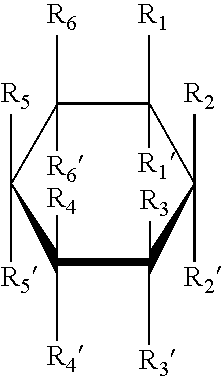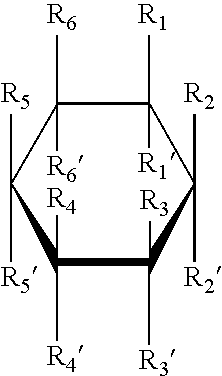Methods of preventing, treating and diagnosing disorders of protein aggregation
a protein aggregation and disorder technology, applied in the field of protein aggregation disorders, can solve the problems of not revealing the use of inositol isomers, no cure or effective treatment, and many work in alzheimer's diseas
- Summary
- Abstract
- Description
- Claims
- Application Information
AI Technical Summary
Problems solved by technology
Method used
Image
Examples
example 2
Prevention of Cognitive Deficits
[0138] The cognitive function of TgCRND8 mice was assessed using the spatial reference memory version of the Morris Water Maze using a five-day trial paradigm (FIGS. 1C-1H). Data from treated and non-treated TgCRND8 mice, and from treated and non-treated non-Tg littermates (n=10 for all combinations) were analyzed using a mixed model of analysis of variance (ANOVA) with treatment (untreated, epi- or scyllo-inositol) and genotype (TgCRND8 versus non-Tg) as `between-subject` factors. TgCRND8 mice treated with either epi- or scyllo-inositol performed significantly better than untreated TgCRND8 mice (p<0.02; FIGS. 1C and D). When compared to treated or non-treated non-Tg littermates, epi-inositol treated TgCRND8 mice had a slightly slower learning curve during the first three days of training. However, after 4 days of training, epi-inositol treated TgCRND8 mice were not statistically different from their non-Tg littermates (FIG. 2E). In contrast, scyllo-i...
example 3
Reduction of Cerebral A.beta. Burden and Amyloid Neuropathology
[0139] At four months of age, untreated TgCRND8 mice have a robust expression of both A.beta.40 and A.beta.42 (Table 1). Epi-inositol treatment as described in Example 1 reduced both A.beta. 40 (43.+-.2% reduction in both soluble and insoluble pools; p.ltoreq.0.05) and A.beta. 42 levels (69% reduction in soluble pool, p=0.005; 28% reduction in insoluble pool, p=0.02) at 4-months of age. However, these improvements were not sustained, and by 6 months of age, brain A.beta. levels rose to levels similar to those observed in untreated TgCRND8 mice (Table 1).
[0140] In contrast, at four months of age, scyllo-inositol treatment decreased total brain A.beta.40 by 62% (p=0.0002) and total brain A.beta.42 by 22% (p=0.0096; Table 1). At 6 months of age, scyllo-inositol treatment caused a 32% reduction in A.beta.40 levels (p=0.04) and 20% reduction in A.beta.42 (p=0.02) compared to untreated TgCRND8 mice.
[0141] Because the decreased...
example 4
Reduction of Glial Reactivity and Inflammation
[0144] Astroglial and microglial reactions are neuropathological features both of human AD and of all amyloid mouse models (Irizarry et al., J Neuropathol Exp Neurol. 56, 965, 1997; K. D. Bomemann et al. Ann N Y Acad Sci. 908, 260, 2000). Therefore, the effect of epi- and scyllo-inositol treatment was investigated on astrogliosis and microgliosis in the brains of TgCRND8 mice (FIGS. 3A-3D). Serial sagittal sections were stained with the astrocytic marker glial fibrillary acidic protein (GFAP) and quantitated for percent brain area covered by astrogliosis. TgCRND8 mice have a high basal astrogliosis at 4-months of age (0.459.+-.0.048%), which increases slightly by 6-months of age (0.584.+-.0.089%), and which is not restricted to plaque areas (FIGS. 2A-C). Epi-inositol decreased the astrogliotic response to 0.388.+-.0.039% at 6-months of age (p=0.04; FIG. 2D-F). Scyllo-inositol, on the other hand, decreased astrogliosis much more efficient...
PUM
| Property | Measurement | Unit |
|---|---|---|
| Weight | aaaaa | aaaaa |
| Weight | aaaaa | aaaaa |
| Weight | aaaaa | aaaaa |
Abstract
Description
Claims
Application Information
 Login to View More
Login to View More - R&D
- Intellectual Property
- Life Sciences
- Materials
- Tech Scout
- Unparalleled Data Quality
- Higher Quality Content
- 60% Fewer Hallucinations
Browse by: Latest US Patents, China's latest patents, Technical Efficacy Thesaurus, Application Domain, Technology Topic, Popular Technical Reports.
© 2025 PatSnap. All rights reserved.Legal|Privacy policy|Modern Slavery Act Transparency Statement|Sitemap|About US| Contact US: help@patsnap.com



